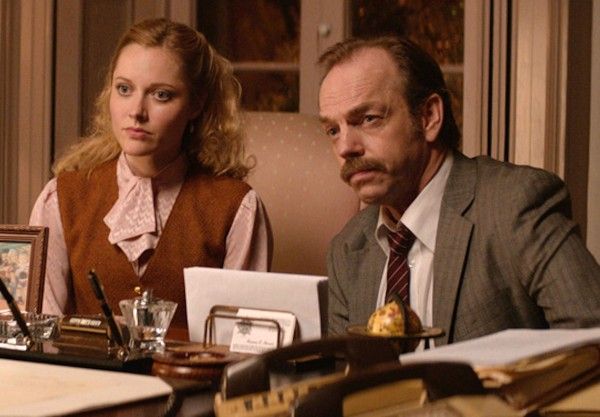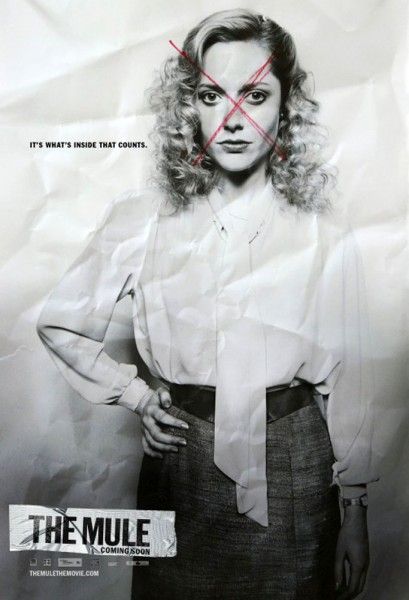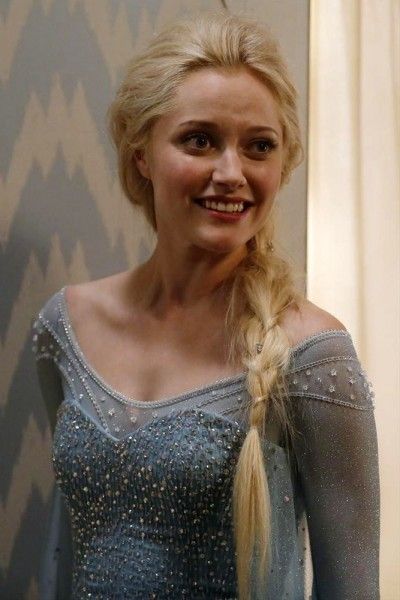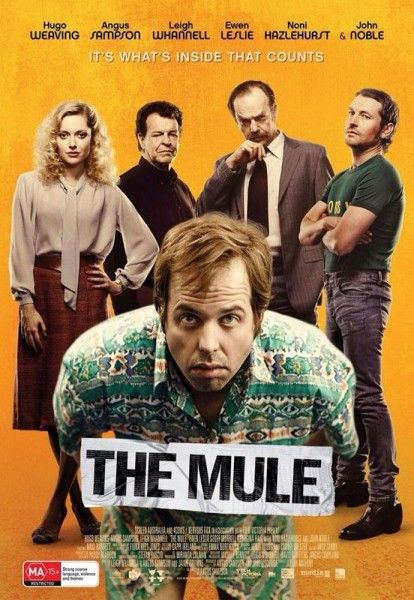Written by Leigh Whannell, Angus Sampson and Jaime Browne, the crime drama The Mule, set in 1983, tells the story of what happens when a naive man (Sampson) with lethal narcotics in his stomach is detained by Australian Federal Police. While locked in a hotel room and watched by cops, criminals, lawyers and his own mother, he's determined to withhold the evidence for as long as he can.
During this exclusive phone interview with Collider, actress Georgina Haig (who plays legal aid lawyer Jasmine Griffiths) talked about what attracted her to The Mule, how she connected to this character, making the role three-dimensional, Jasmine’s secret ambitions, and why making this movie available to so many different people at the same time could really help give it a fair shot. She also talked about being the physical embodiment of Elsa from Frozen on Once Upon A Time, feeling very protective of her, and getting to wear that dress, along with what being a part of Fringe means to her and whether she’d like to do more American television. Check out what she had to say after the jump.
Collider: How did you come to this film?
GEORGINA HAIG: I was actually in Charleston, South Carolina, filming a pilot, and I got sent the script, read it and just thought it was brilliant. The whole concept was just horrifically intriguing. I just thought it was such a great example of a wonderful thriller. It was a suspenseful script with great elements of black comedy and great characters. Everybody is hiding something. I just read it and went, “I want to see that movie!” If you have that feeling when you read a script, you want to be a part of it.
Were there things about this particular character that stood out for you, either because you connected to her or because you thought it would be a fun challenge to tackle?
HAIG: Yeah, I definitely connected to her a lot. I could relate to her ambition and her frustration. I knew a lot of people who had gone through things like that. I had a lot of things, in reality, to base her on. She has to deal with these pretty intimidating guys in a really smart, funny way. I just thought that was great. I really wanted to tackle that. By making her not just the savior or an angel-like being who’s going to help him, they made her quite self-serving. They gave her her own secrets that she was hiding and her own ambitions. That, to me, made her more three-dimensional. And then, there was her big hair. The hair was three-dimensional, and so was the character.
Did you think about what it is in this woman that enabled her to be in this profession, at this time period, and why she’d be willing to put up with being treated the way she was?
HAIG: Yeah, I think she had a privileged upbringing and a best of the best education. She probably was going against the norm by working in legal aid. I think she could have done whatever she wanted, but she wanted to make a difference. She did want to save the world, and I think she got frustrated and found that it wasn’t as simple as that. And I think she did start to regret her decision to go into it. I think she wanted to get the media involved to boost the profile of this case because it would boost her profile. Secretly, she has a lot more ambitions than she’s told herself. She is a professional woman, in the early ‘80s, who’s ambitious.
This film is ambitiously being released on digital platforms in Australia, New Zealand, the States and Canada, all at the same time. In the past, when you made a movie, you could only hope that people would show up in the theater to see it, or maybe check it out on home video later, but now they can watch at home, on their TV, their computer or their iPad. Do you think that works to the advantage of smaller films like this that are looking for an audience?
HAIG: I’ve never really been a part of a movie that’s approached the release in this way, so I’m really curious to see what happens. When Australian movies premiere in Australia, they’re often given a really limited release and not a lot of publicity. They don’t get a lot of numbers, so everyone just writes off the movie as not very good, and that’s a real problem. So, I get why these filmmakers want to release movies in a different way, to make them available to everyone around the world and to give it a fair shot. If it does well on the digital release, then maybe Australian audiences will take more notice. That sounds terrible, but it’s the case. It’s just so hard for Australian films to get an audience in Australia. The American films just have so much more publicity and so much more money behind them that it’s so hard to compete. So, I do understand why they’re doing it.
At this point, would you say that you have more fans because of your work on Fringe, Reckless and Once Upon A Time, or do you have more kids thinking that you’re really Elsa?
HAIG: At this point, it’s probably Elsa because it’s so recent. That show has very high ratings, and Elsa is in people’s minds right now. The whole Frozen thing is such a phenomenon. But it’s funny, I don’t get recognized much. I think it’s just such a transformation with the hair, the make-up and the dress. And it’s gotten a much bigger audience than anything else I’ve ever done.
What’s been the best part about being the actual physical embodiment of an animated character that is so beloved by people?
HAIG: It was just amazing. To get to wear that dress and to be made up into her, I just felt really honored. I did feel a responsibility, as well, to portray her in a way that made people happy. That character means so much to so many people. I think Elizabeth Lail, who played Anna, and I both felt a responsibility to make these characters real, but also have the spirit the people loved from the Disney film reflected in how we realized them. I think we developed our sisterly relationship on the show really well. I just get on with Elizabeth so well. We’re really close now, and we had a lot of fun. We worked really hard to try to make that relationship work because we knew that relationship was so important to the film and to people, as well.
When you become a part of something like that, that’s so in the culture now, does it make you look at the animated version of her different than you used to? Do you feel a connection to it?
HAIG: I always feel very protective of her. I hated taking off my costume, for the last time. It was really sad for me because I’m not her anymore. I had to say goodbye. I was sad about that because I loved getting to be her. It was interesting, researching why she meant so much to people. I just think there hadn’t been a Disney character that was so in conflict with themselves, who was an anti-villain. She was technically the villain, but the actual villain was the emotion of fear. The fact that she had to deal with that, and then she was so isolated because she couldn’t accept herself for who she was, I just think people related to that so much. It was really interesting, looking at what it was about Elsa that people connected to.
Fringe was also a show that had a very devoted fan following. That really kept it on the air as long as it was. What does it mean to you, personally, to have been a part of that show, and to have done so in such a memorable way?
HAIG: I only did five episodes, but because I was the daughter of Anna [Torv] and Josh [Jackson], it was a crucial character. It was quite a big deal for me, as an actor, just because it was my first international job. I’d been auditioning so much, to try to get work in the States, or wherever, and that was the first international job that I landed. It meant a lot to me and I really wanted to do a good job. It was crazy ‘cause that first episode, Anna wasn’t even in it. It was just me, and it was this whole other show, just for one episode. It was this bizarre thing, but it was great. I loved doing that. And John Noble, who’s also in The Mule, played my grandfather and really took me under his wing. He sat me down and said, “If you want to ask me anything, you can.” That was so nice and so generous of him.
Now that you’ve had the experience of doing American television, are you looking to do more of it?
HAIG: Yeah, as long as the character is really great and it’s a project that I believe in. I think you’re just always trying to find really great, interesting female roles. That’s the thing for me. You do have to think about what you’re signing up for. With some of these shows, you sign a contract for five or six years, so you do want to make sure it’s something you can do for that long. I’m just trying to find characters like that.
Just looking at your role in The Mule and at your work on American television, you’ve played such different characters. Do you try to only take roles that are so different from each other, or do you just feel really lucky that you’ve had such variety in your work?
HAIG: I’ve just been really fortunate with Lee Anne in Reckless, Elsa in Once Upon A Time, Jasmine in The Mule, and Paula Yates in the INXS tele movie. They’re all just so different. I just love that I’ve gotten to do that. The cool thing is that I think they all have elements of strength and vulnerability, but they all couldn’t be more different. I think that’s all just a bit of luck that I’ve gotten to do such different stuff. I don’t know if it’s a good thing to not do something, just ‘cause it’s too similar to what you’ve done. You can always find ways to make it different, as long as it’s a really well-written script and well-written character.
The Mule is now available in theaters and on VOD.





